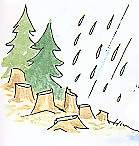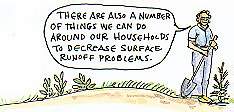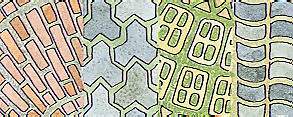 Spare
That Shrub Spare
That Shrub
–
Do Your Part To Control Erosion
 |
Rain
has long been the single word most identified with the Puget
Sound region. In a watershed that consists largely of forest
land and farmland, most rain soaks slowly into the ground and
gradually drains to nearby surface waters or into the groundwater.
As forests and hillsides are cleared and wetlands are filled
for development, more of the water runs off instead of soaking
into the ground. As the Puget Sound basin has developed, changes
in land use have increased seasonal flooding. |
 |
 |
Roofs, roads,
parking lots, sidewalks, driveways and other hard surfaces are
impervious to rain. Virtually all of the rain that falls on these
surfaces has nowhere to go but downhill, fast. As a result, flooding
increases in frequency and severity. A short, intense rainstorm
that only slightly raised water levels in the past, now turns
a stream into a torrent. The speed of water moving across the
land and in the streams increases and accelerates soil erosion.
Much of the
soil washed off vacant lots, cleared land, uncontrolled construction
sites, and from road cuts is carried into streams and can eventually
reach Puget Sound. In streams, this sediment smothers plants and
animals that live in the shallows and clogs the clean gravel needed
by spawning salmon. In bays and inlets of the Sound, this sediment
smothers lingcod spawning grounds and eelgrass beds. This runoff
may also include a variety of pollutants. Metals from downspouts
and pipes, paints, brake linings, engine drippings and tires join
nutrients from lawn fertilizers, detergents, animal wastes, and
failing septic tanks. Bacteria and oxygen-demanding substances
from farm animal and pet waste, failing septic systems and combined
sewer outflows are carried downstream by the runoff. As if these
weren’t enough, oil and grease from parking lots, roads, service
stations and illegal disposal of waste oil into storm drains combines
with other toxic chemicals that may be released from industrial
and commercial businesses.
 Dealing
with Surface Runoff Dealing
with Surface Runoff
What can be done to treat these rainy day blues? Natural wetlands
slow the flow of runoff and filter pollutants from the water passing
through them. Help to preserve wetlands in your neighborhood and
throughout Puget Sound. When development occurs, insist that best
management practices be used. These include detention ponds which
allow pollutants to settle, infiltration devices which channel
runoff through the soil layer, and grassy swales which use vegetation
to filter runoff.
 Reduce
your use of impervious surfaces. Use spaced paving stones instead
of concrete, ground cover instead of grass, and pervious asphalt
instead of standard. Reduce
your use of impervious surfaces. Use spaced paving stones instead
of concrete, ground cover instead of grass, and pervious asphalt
instead of standard. |
 Plant
grass along and in drainage ditches or channels to slow the
rate of runoff and help filter pollutants. Plant
grass along and in drainage ditches or channels to slow the
rate of runoff and help filter pollutants. |
 Where
impermeable surfaces are used, divert rain from the paved surfaces
onto grass or into vegetation to permit gradual absorption. Where
impermeable surfaces are used, divert rain from the paved surfaces
onto grass or into vegetation to permit gradual absorption. |
 Use
grass-lined swales, berms, and basins to control runoff on your
property, reduce its speed, and increase the time over which
the runoff is released. Use
grass-lined swales, berms, and basins to control runoff on your
property, reduce its speed, and increase the time over which
the runoff is released. |
 Preserve
the established trees around your home and in your neighborhood.
Plant new trees and shrubs to encourage excess rainwater to
filter slowly into the soil. Plant and maintain a vegetated
buffer strip at the base of steep slopes and along water bodies. Preserve
the established trees around your home and in your neighborhood.
Plant new trees and shrubs to encourage excess rainwater to
filter slowly into the soil. Plant and maintain a vegetated
buffer strip at the base of steep slopes and along water bodies. |
 Resod
bare patches in your lawn as soon as possible and minimize bare
soil in your garden to avoid erosion. Resod
bare patches in your lawn as soon as possible and minimize bare
soil in your garden to avoid erosion. |
 Install
gravel trenches along driveways or patios to collect water and
allow it to filter into the soil. To be most effective, trenches
should be one foot wide by three feet deep. Grass swales, low
areas in the lawn, can be used to move water from one area to
another. Install
gravel trenches along driveways or patios to collect water and
allow it to filter into the soil. To be most effective, trenches
should be one foot wide by three feet deep. Grass swales, low
areas in the lawn, can be used to move water from one area to
another. |
 If
you build a new home, ask your builder to leave as much of the
original vegetation as possible on site. Before you start construction
grading, acquire a copy of the Associated General Contractors
booklet, Waste Disposal and Erosion and Sediment Control Methods,
by calling (206) 284 -0061. Read the booklet and share it with
your builder. If
you build a new home, ask your builder to leave as much of the
original vegetation as possible on site. Before you start construction
grading, acquire a copy of the Associated General Contractors
booklet, Waste Disposal and Erosion and Sediment Control Methods,
by calling (206) 284 -0061. Read the booklet and share it with
your builder. |
Permeable
Paving Surfaces
Because so many of our human landscape features are impervious,
a few words about using paving surfaces that allow rainwater to
soak into the ground seem in order. There are many materials that
provide the durability of concrete while allowing rainwater to
filter into ground.
 Bricks,
interlocking pavers, precast concrete lattice pavers, or flat
stones make an attractive, durable walkway. If placed on well
drained soil or on a sand or gravel bed, these modular pavers
allow rainwater infiltration. To control weeds growing in the
spaces between the pavers, consider Corsican mint or moss as a
natural way to crowd out weeds and add beauty to the paved area. Bricks,
interlocking pavers, precast concrete lattice pavers, or flat
stones make an attractive, durable walkway. If placed on well
drained soil or on a sand or gravel bed, these modular pavers
allow rainwater infiltration. To control weeds growing in the
spaces between the pavers, consider Corsican mint or moss as a
natural way to crowd out weeds and add beauty to the paved area.
 Wood
decks, usually installed for their functional good looks, can
serve as a form of porous pavement. Redwood, cedar, or treated
wood are as durable as most other paving surfaces. The spacing
in the decking allows rainwater to drain directly onto the soil
surface and soak into the ground. Maintaining the distance between
the soil surface and the decking recommended by your county building
department will minimize risk of wood rot. Wood
decks, usually installed for their functional good looks, can
serve as a form of porous pavement. Redwood, cedar, or treated
wood are as durable as most other paving surfaces. The spacing
in the decking allows rainwater to drain directly onto the soil
surface and soak into the ground. Maintaining the distance between
the soil surface and the decking recommended by your county building
department will minimize risk of wood rot.
New, porous
materials are also becoming available. For example, porous asphalt
is similar to conventional asphalt in durability and cost. You
can use porous asphalt on your new driveway and encourage its
use on streets and parking lots in your community. For specifics,
call the Washington office of the Asphalt Institute at (859) 288-4960
or the Washington
Department of Ecology at (360) 407-6000..
|
|
|




